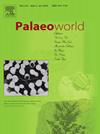An Ordovician (Whiterockian) marine community from Sonora, Mexico: Paleoecology and paleobiogeographic affinity with North America and Argentina
IF 1.7
3区 地球科学
Q2 PALEONTOLOGY
引用次数: 0
Abstract
A Lower and Middle Ordovician sequence, containing an abundant biota of cyanobacteria, bryozoans, brachiopods, gastropods, cephalopods, trilobites, and echinoderms, is exposed at Rancho Las Norias in the central part of the state of Sonora, Mexico. This sequence that consists of wackestone, packstone, and grainstone is deposited in a shallow water marine environment within the photic zone, as indicated by the presence of cyanobacteria such as Nuia sibirica. A paleoecological study was performed on one fossiliferous level S1 at the middle part of the sequence in this study, where 113 individuals of 11 taxa were analyzed, which allows to reconstruct the paleocommunity structure of this calcareous layer. The paleocommunity consists mainly of brachiopods, gastropods, and trilobites. The applied paleoecological indices (Dominance and Evenness of Simpson, Diversity of Shannon-Weaver, Diversity of Menhinick, and Total Richness of Chao) indicate a benthic marine community constituted mainly by sessile-suspension feeders, and brachiopods (Orthidiella cf. O. longwelli) are the dominant forms. A Jaccard Similarity Index was also applied, where a similarity of ∼100% was obtained between Canada and Mexico, ∼80% between the USA and Mexico, and ∼50% between Argentina and Mexico, thus confirming the Ordovician paleogeographic affinity of these localities with Laurentia. The Ordovician of northwestern Mexico corresponds to the southernmost deposits of the North American craton and is an essential link in understanding the relationship between North and South America.
墨西哥索诺拉的奥陶纪(白垩纪)海洋群落:古生态学以及与北美和阿根廷的古生物地理亲缘关系
在墨西哥索诺拉州中部的 Rancho Las Norias,出露了一个中下奥陶统的岩层,其中含有丰富的生物群,包括蓝藻、双壳类、腕足类、腹足类、头足类、三叶虫和棘皮动物。该地层由瓦克石、包石和纹理石组成,沉积于光照区内的浅水海洋环境中,蓝藻(如 Nuia sibirica)的存在表明了这一点。本研究对该层序中段的一个化石层 S1 进行了古生态学研究,分析了 11 个类群的 113 个个体,从而重建了该钙质层的古群落结构。古群落主要由腕足动物、腹足类和三叶虫组成。应用的古生态指数(辛普森指数的优势度和均匀度、香农-韦弗指数的多样性、门希尼克指数的多样性和赵氏指数的总丰富度)表明,底栖海洋群落主要由无柄悬浮取食动物构成,腕足动物(Orthidiella cf. O. longwelli)是主要形式。此外,还应用了 Jaccard 相似性指数,加拿大与墨西哥之间的相似性为 100%,美国与墨西哥之间的相似性为 80%,阿根廷与墨西哥之间的相似性为 50%,从而证实了这些地方与劳伦西亚的奥陶纪古地理亲缘关系。墨西哥西北部的奥陶纪相当于北美克拉通最南端的沉积,是了解南北美洲关系的重要环节。
本文章由计算机程序翻译,如有差异,请以英文原文为准。
求助全文
约1分钟内获得全文
求助全文
来源期刊

Palaeoworld
PALEONTOLOGY-
CiteScore
4.00
自引率
5.90%
发文量
95
期刊介绍:
Palaeoworld is a peer-reviewed quarterly journal dedicated to the study of past life and its environment. We encourage submission of original manuscripts on all aspects of palaeontology and stratigraphy, comparisons of regional and global data in time and space, and results generated by interdisciplinary investigations in related fields. Some issues will be devoted entirely to a special theme whereas others will be composed of contributed articles. Palaeoworld is dedicated to serving a broad spectrum of geoscientists and palaeobiologists as well as serving as a resource for students in fields as diverse as palaeobiology, evolutionary biology, taxonomy and phylogeny, geobiology, historical geology, and palaeoenvironment.
Palaeoworld publishes original articles in the following areas:
•Phylogeny and taxonomic studies of all fossil groups
•Biostratigraphy, chemostratigraphy, chronostratigraphy
•Palaeoecology, palaeoenvironment and global changes throughout Earth history
•Tempo and mode of biological evolution
•Biological events in Earth history (e.g., extinctions, radiations)
•Ecosystem evolution
•Geobiology and molecular palaeobiology
•Palaeontological and stratigraphic methods
•Interdisciplinary studies focusing on fossils and strata
 求助内容:
求助内容: 应助结果提醒方式:
应助结果提醒方式:


